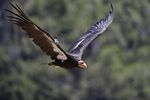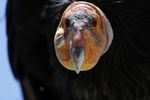California condors return to the skies after near extinction - Phys.org
←
→
Page content transcription
If your browser does not render page correctly, please read the page content below
California condors return to the skies after
near extinction
20 September 2017, by Terence Chea
reverse course.
One of the world's largest birds with a wingspan up
to 10 feet, the condor once patrolled the sky from
Mexico to British Columbia. But its population
plummeted in the 20th century due to lead
poisoning, hunting and habitat destruction.
In 1987, wildlife officials captured the last remaining
22 condors and took them to the San Diego and
Los Angeles zoos to be protected and bred in
captivity.
Those efforts have led to a slow but steady
recovery for a species that reproduces slowly
In this Wednesday, June 21, 2017 photo, a California compared with other birds. There are now roughly
condor sits in the Ventana Wilderness east of Big Sur, 450 condors, including about 270 in the wild in
Calif. Three decades after being pushed to the brink of California, Arizona, Utah and northeastern Mexico.
extinction, the California condor is staging an impressive
comeback, thanks to captive-breeding programs and
reduced use of lead ammunition near their feeding
grounds. (AP Photo/Marcio Jose Sanchez)
In a remote, rugged valley overlooking the Pacific
Ocean, researchers closely monitor an
endangered icon: the California condor.
The giant vultures flap their wings and circle the
sky before perching on branches and observing
their observers. Wildlife biologist Amy List uses a
handheld antenna to track the birds, which wear
radio transmitters and numbered tags.
"If we don't know what they're doing, we don't In this Wednesday, June 21, 2017 photo, California
know what's going wrong," said List, who works for condors huddle around a watering hole in the Ventana
Wilderness east of Big Sur, Calif. Three decades after
the Ventana Wildlife Society, which manages the
being pushed to the brink of extinction, the California
condor sanctuary in Big Sur. condor is staging an impressive comeback, thanks to
captive-breeding programs and reduced use of lead
Three decades after being pushed to the brink of ammunition near their feeding grounds. (AP
extinction, the California condor is making a Photo/Marcio Jose Sanchez)
comeback in the wild, but constant vigilance is
needed to ensure the endangered bird doesn't
1/4Plans also are underway to release some captive-
bred condors in Redwood National Park in 2019 to In this Wednesday, June 21, 2017 photo, a California
establish a population near the California-Oregon condor sits perched on a tree branch in the Ventana
border. Wilderness east of Big Sur, Calif. Three decades after
being pushed to the brink of extinction, the California
condor is staging an impressive comeback, thanks to
Federal officials said in August that for the first time
captive-breeding programs and reduced use of lead
in nearly 40 years, condors were roosting in the ammunition near their feeding grounds. (AP
Blue Ridge National Wildlife Refuge, expanding to Photo/Marcio Jose Sanchez)
their historical range in the southern Sierra Nevada.
Another milestone was reached this summer: the
first "third generation" condor was born in the wild
While condors still face threats from exposure to
in California since the 1980s. mercury and the pesticide DDT, biologists say the
biggest danger is lead ammunition, which can
"We're seeing very encouraging results that the poison the scavengers when they eat dead animals
condors can become self-sustaining again," said shot with lead bullets. California banned the use of
Kelly Sorenson, who heads the conservation group. lead ammunition near condor feeding grounds in
2008 and will be the first state to ban lead bullets in
all hunting in 2019.
"We're already starting to see fewer lead deaths.
The condors are surviving longer. Their blood-lead
levels are coming down," Sorenson said.
Some gun owners complain that copper bullets are
more expensive and less effective than lead and
point to other possible sources of lead, such as
paint and metal garbage.
"Condors are getting lead poisoning. The question
is, are they getting it from lead ammunition?" said
Chuck Michel, president of the California Pistol and
Rifle Association.
In this Wednesday, June 21, 2017 photo, a California
2/4condor takes flight in the Ventana Wilderness east of Big and wildlife biologist Amy List monitor California condors
Sur, Calif. Three decades after being pushed to the brink in the Ventana Wilderness east of Big Sur, Calif. Three
of extinction, the California condor is staging an decades after being pushed to the brink of extinction, the
impressive comeback, thanks to captive-breeding California condor is staging an impressive comeback,
programs and reduced use of lead ammunition near their thanks to captive-breeding programs and reduced use of
feeding grounds. (AP Photo/Marcio Jose Sanchez) lead ammunition near their feeding grounds. (AP
Photo/Marcio Jose Sanchez)
Meanwhile, the San Diego Zoo celebrated the birth
of its 200th condor this year.
"While we were caring for the birds, trying to protect
them and provide sanctuary, we were literally
writing the book how you propagate a species, how
you genetically manage it and prepare it for release
back in the wild," Michael Mace, the zoo's birds
curator.
After up to a year at the zoo, chicks are taken to a
release site such as the Big Sur sanctuary, where a
flock has grown to about 90 condors that travel
between Big Sur and Pinnacles National Park.
They scavenge, breed and raise chicks on their
own, under the close watch of List, the wildlife
In this Wednesday, June 21, 2017 photo, Ventana
biologist, and her colleagues.
Wildlife Society executive director Kelly Sorenson poses
for a portrait inside a cabin used by researchers to study
"I hope that I'm out of a job soon because condors California condors in the Ventana Wilderness east of Big
don't need to be managed in the future," she said. Sur, Calif. Three decades after being pushed to the brink
"I hope that they're self-sustaining and wild and of extinction, the California condor is staging an
free, and nobody needs to trap or tag or monitor impressive comeback, thanks to captive-breeding
them at all." programs and reduced use of lead ammunition near their
feeding grounds. "We're seeing very encouraging results
that the condors can become self-sustaining again," said
Sorenson. (AP Photo/Marcio Jose Sanchez)
In this Wednesday, June 21, 2017 photo, Ventana
Wildlife Society executive director Kelly Sorenson, right,
3/4In this Wednesday, June 21, 2017 photo, Wildlife
biologist Amy List observes California condors up close
from inside an enclosure in the Ventana Wilderness east
of Big Sur, Calif. Three decades after being pushed to
the brink of extinction, the California condor is staging an
impressive comeback, thanks to captive-breeding
programs and reduced use of lead ammunition near their
feeding grounds. "If we don't know what they're doing, we
don't know what's going wrong," said List. (AP
Photo/Marcio Jose Sanchez)
In this Wednesday, June 21, 2017 photo, wildlife biologist
Amy List shows some led bullets like the ones that kill
California condors after the bird eats a contaminated
carcass in the Ventana Wilderness east of Big Sur, Calif.
Three decades after being pushed to the brink of
extinction, the California condor is staging an impressive
comeback, thanks to captive-breeding programs and
reduced use of lead ammunition near their feeding
grounds. "I hope that I'm out of a job soon because
condors don't need to be managed in the future," List
said. "I hope that they're self-sustaining and wild and
free, and nobody needs to trap or tag or monitor them at
all." (AP Photo/Marcio Jose Sanchez)
© 2017 The Associated Press. All rights reserved.
APA citation: California condors return to the skies after near extinction (2017, September 20) retrieved
16 May 2019 from https://phys.org/news/2017-09-california-condor-flight-wild-extinction.html
This document is subject to copyright. Apart from any fair dealing for the purpose of private study or research, no
part may be reproduced without the written permission. The content is provided for information purposes only.
4/4
Powered by TCPDF (www.tcpdf.org)You can also read


























































